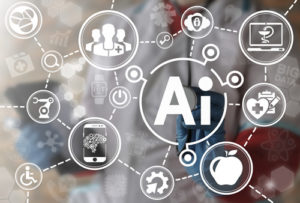What is the potential of artificial intelligence (AI) in higher education? A new report from The Learning House, Artificial Intelligence in Higher Education: Current Uses and Future Applications, outlines some of the ways AI is impacting higher ed and also examines implementation challenges.
The report also highlights important policy guidance and recommendations that are likely to accelerate AI innovation or, if unrealized, stifle its growth and adoption. For example, the Family Educational Rights and Privacy Act (FERPA) last updated in 2001, predates many common education technologies including smartphones, tablets, wireless data, MOOCs, and even online education programs in general. The brief also cites necessary changes to policies on data security and accreditation.
“Imagine a world where grading a full course’s papers takes 15 minutes, and teaching assistants, student advisers and enrollment counselors are available 24 hours a day, seven days a week. Imagine a world where faculty can create immersive, real-world experiences for students without leaving the classroom, map out a class’s misconceptions about material down to discrete learning outcomes and select a series of intervention strategies targeted to each student’s unique learning needs,” the authors write. “Many of these elements have always been possible through extensive human effort, but AI will make this world available at scale, freeing up faculty and staff to deliver a more personal, tailored experience that better meets students’ needs and prepares them for success.”
In the report, the authors identify four key areas in which AI is impacting higher education, as well as opportunities for future growth.
4 areas in which AI is impacting higher ed
1. Student acquisition: AI can provide 24/7 personalized assistance to students as they progress through the enrollment process. In the future, it could help schools target recruitment to students who are likely to succeed at their institution and in certain majors, leading to higher enrollment and retention rates.
2. Learning and instruction: AI can help instructors grade and supply struggling students with the resources they need to succeed. In the future, this could free up faculty members to oversee large classes while still engaging with students on a deeper level.
3. Student affairs: AI can deliver personalized degree planning and intervene with struggling students. In the future, it could anticipate students’ academic needs based on predictive data and past performance, and then proactively supply appropriate resources, such as additional tutoring or advising.
4. Institutional efficiency: AI can pull together information from multiple campus systems and use the data to guide administrative decisions such as course offerings. In the future, AI could help institutions understand local employers’ hiring needs and create curricula that prepares students to fill them.
The possibilities are both exciting and achievable, but there do exist a number of challenges that could prevent new programs from flourishing on campuses. These challenges include:
1. Accreditation and financial aid requirements should be updated to address the reimagination of academic achievement and instructional support provided by AI.
2. Privacy regulations such as FERPA need to be updated in order to address the ability of AI systems to track data and use it for predictive analytics.
3. If AI takes over some current job responsibilities such as grading and answering students’ questions, administrators and faculty members will be able to shift their focus to solving more complex problems and connecting with students on deeper levels. Administrative staff should accommodate this shift as much as possible.
The authors offer a few recommendations to help higher-ed leaders meet the opportunities and challenges AI presents in the higher ed realm:
1. Examine when to implement (short- or long-term)
2. Identify in what areas of the institution it would be most helpful
3. Determine how to protect students’ privacy while using data to help them
4. Examine what the university’s definition of success is regarding AI implementation
- Digital innovation and human connection are reshaping higher ed - June 30, 2025
- Amid uncertainty, IT leaders outline priorities for higher ed - June 27, 2025
- 10 dimensions of AI readiness - June 24, 2025
